Physical Address
304 North Cardinal St.
Dorchester Center, MA 02124
Physical Address
304 North Cardinal St.
Dorchester Center, MA 02124
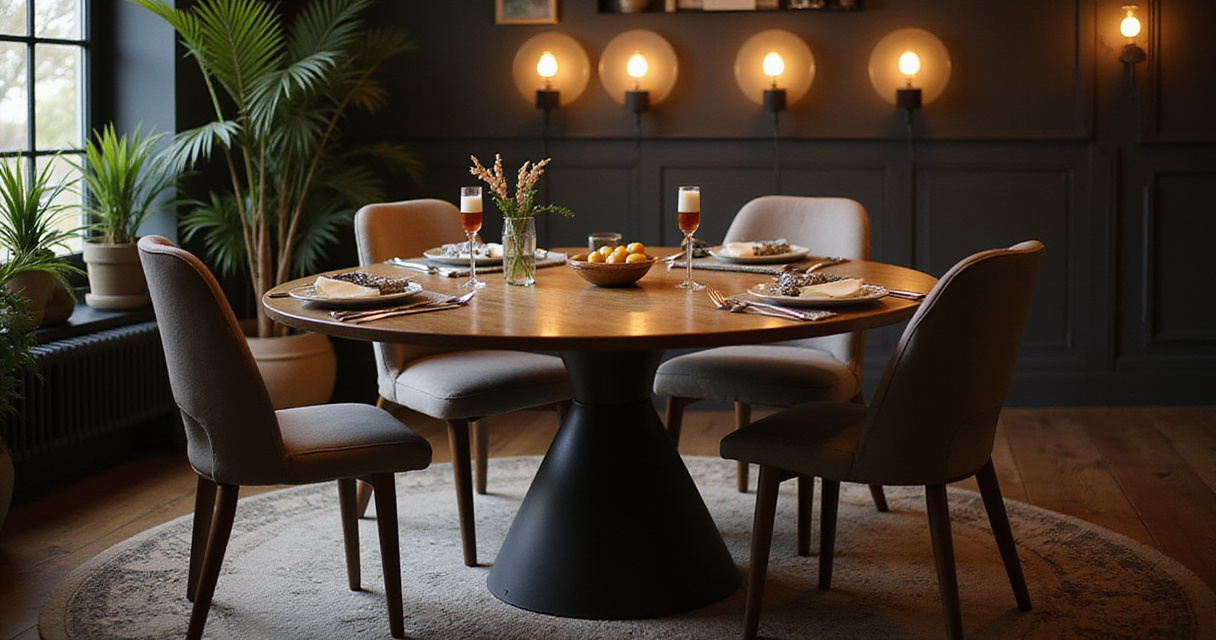
Discover 18 proven small dining room ideas to maximize space and style. From fold-down tables to strategic lighting, transform your compact dining area today.
Creating a functional dining space in a compact home requires more than just squeezing furniture into available corners. When you’re working with limited square footage, every design decision carries extra weight. The challenge isn’t simply finding room for a table and chairs—it’s crafting a space that feels intentional, welcoming, and surprisingly spacious despite its modest dimensions.
The most successful small dining room ideas focus on strategic choices that serve multiple purposes. Rather than fighting against your space constraints, these approaches work with them, transforming limitations into opportunities for creative solutions. From furniture that disappears when not needed to visual tricks that expand perceived boundaries, the right strategies can make your compact dining area feel both larger and more purposeful.
Whether you’re dealing with a narrow galley kitchen, an awkward nook, or a corner of your living room that needs to multitask, these 18 proven techniques will help you maximize every inch while creating a dining space you’ll actually want to use.
Sharp corners become obstacles when space is precious. A round dining table eliminates these navigation challenges, allowing people to move around the furniture more naturally. The curved edge creates a gentler boundary that doesn’t fight against foot traffic, making even tight spaces feel less cramped and more welcoming.

Beyond improved circulation, round tables often seat more people than their rectangular counterparts in the same footprint. Without designated head or foot positions, you can squeeze in an extra chair when needed. The continuous edge also fosters more intimate conversations, bringing everyone closer together around the shared surface.
What makes this design special is the way it softens the entire room’s geometry, creating flow patterns that feel more organic than forced.
Daily life rarely requires the same seating capacity as special occasions. An extendable table bridges this gap perfectly, offering a compact footprint for everyday meals while expanding to accommodate dinner parties or family gatherings. This flexibility prevents you from being locked into either insufficient seating or a permanently oversized table that dominates the room.
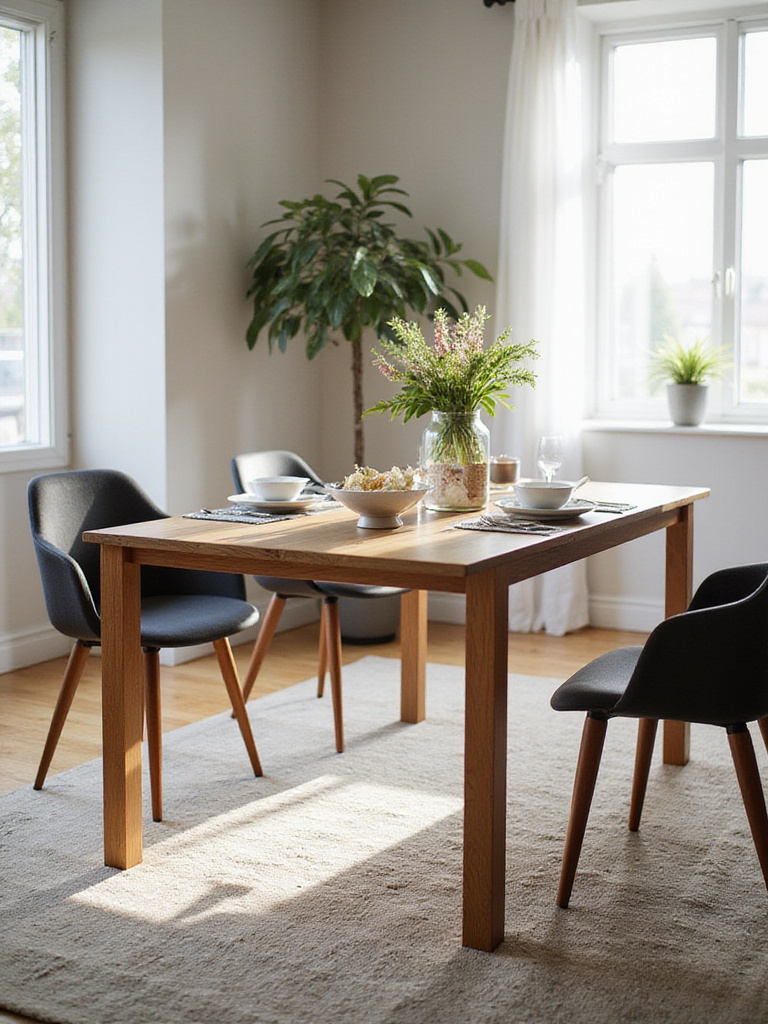
Quality extension mechanisms have evolved significantly, with many options featuring smooth, intuitive operation that one person can manage easily. Whether you choose butterfly leaves, drop-leaf designs, or pull-apart systems, the key is finding one that stores additional surface area efficiently without requiring separate storage space for loose pieces.
The magic of this piece lies in its ability to transform your room’s capacity instantly, potentially doubling your seating without requiring a larger permanent footprint.
Individual chairs demand significant clearance for pulling out and maneuvering, often requiring 18-24 inches behind each seat. Benches eliminate much of this spatial requirement while typically seating more people in the same linear distance. A single bench can often accommodate three people where only two chairs would fit, maximizing your seating efficiency.
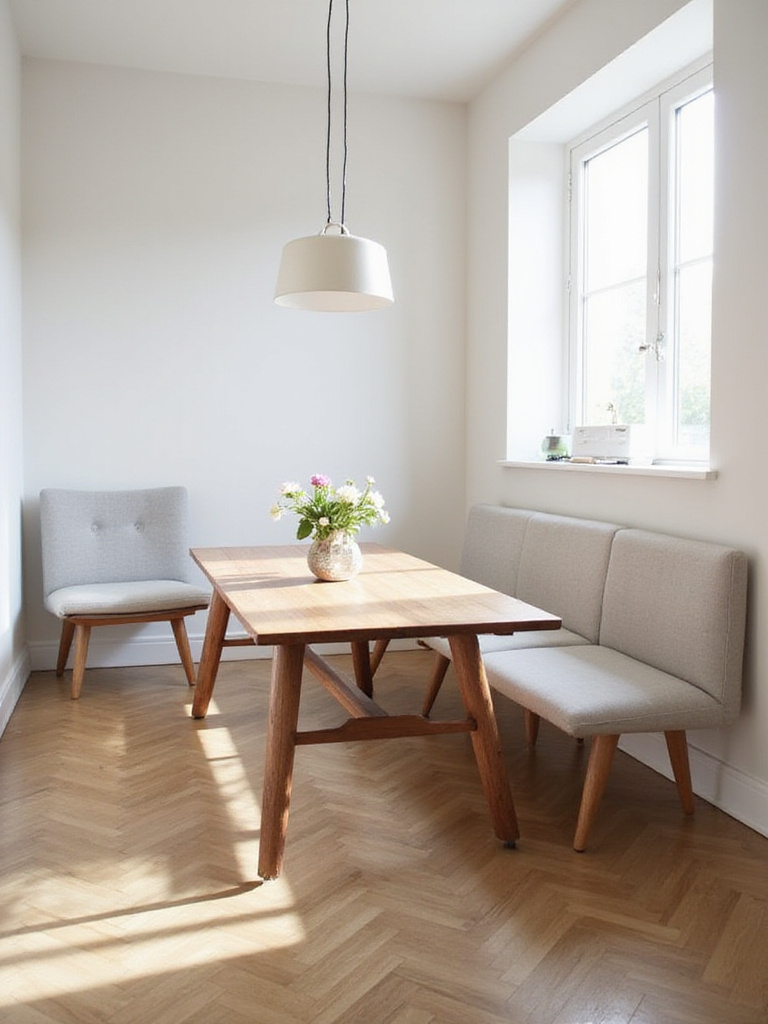
Benches also create cleaner sight lines across the room. Without multiple chair backs interrupting the view, the space feels less cluttered and more cohesive. Many bench designs tuck completely under the table when not in use, essentially disappearing from the room’s footprint and freeing up valuable floor area for other activities.
The unexpected pairing that always works is combining a bench on one side with chairs on the other, creating asymmetrical seating that feels intentional rather than mismatched.
Corners represent some of the most underutilized real estate in any room. A custom banquette transforms this dead space into highly functional seating that can accommodate more people than traditional chairs while requiring zero clearance on two sides. This built-in approach maximizes every available inch while creating a cozy, restaurant-style dining experience.

The construction process allows for complete customization of dimensions, ensuring perfect fit and optimal comfort. Integrating storage beneath the seats adds valuable hidden space for table linens, seasonal items, or dining accessories. The fixed nature of banquette seating also means you can position the table closer to the walls, further optimizing the room’s layout.
Professional stylists approach this by first measuring the corner carefully, then designing the banquette to leave adequate table clearance while maximizing seating capacity within the available footprint.
When your dining area needs to serve multiple functions throughout the day, a wall-mounted fold-down table offers unmatched versatility. This solution completely eliminates the table’s footprint when not needed, instantly reclaiming 10-20 square feet of floor space for other activities. The transformation from open room to functional dining area takes seconds.
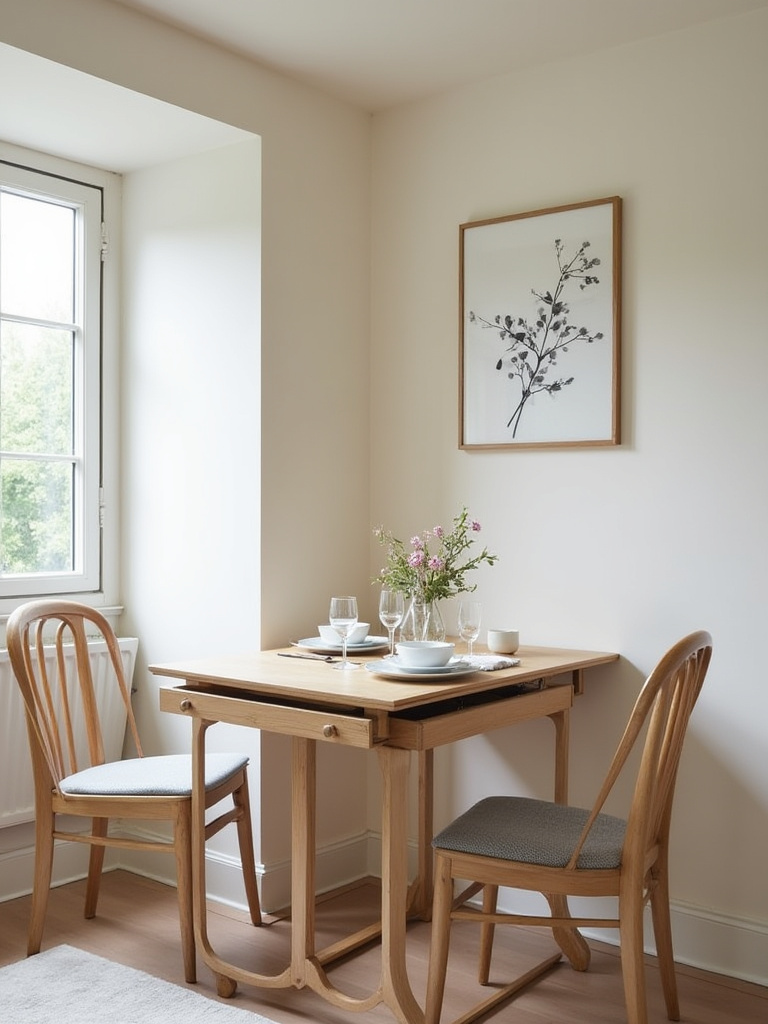
Modern fold-down mechanisms are engineered for smooth operation and reliable support, capable of handling full dinner service for multiple people. The key is selecting appropriate mounting hardware and ensuring the installation hits wall studs for maximum stability. Many designs include integrated leg supports that deploy with the table surface for additional stability.
The environmental story behind this piece began with the recognition that urban living requires furniture to work harder, adapting to changing needs rather than consuming space permanently.
Bulky furniture overwhelms small spaces both physically and visually. Choosing pieces with thin legs, narrow frames, and streamlined silhouettes allows more floor area to remain visible, creating the illusion of greater space. This approach prioritizes visual lightness over substantial mass, making the room feel less congested.
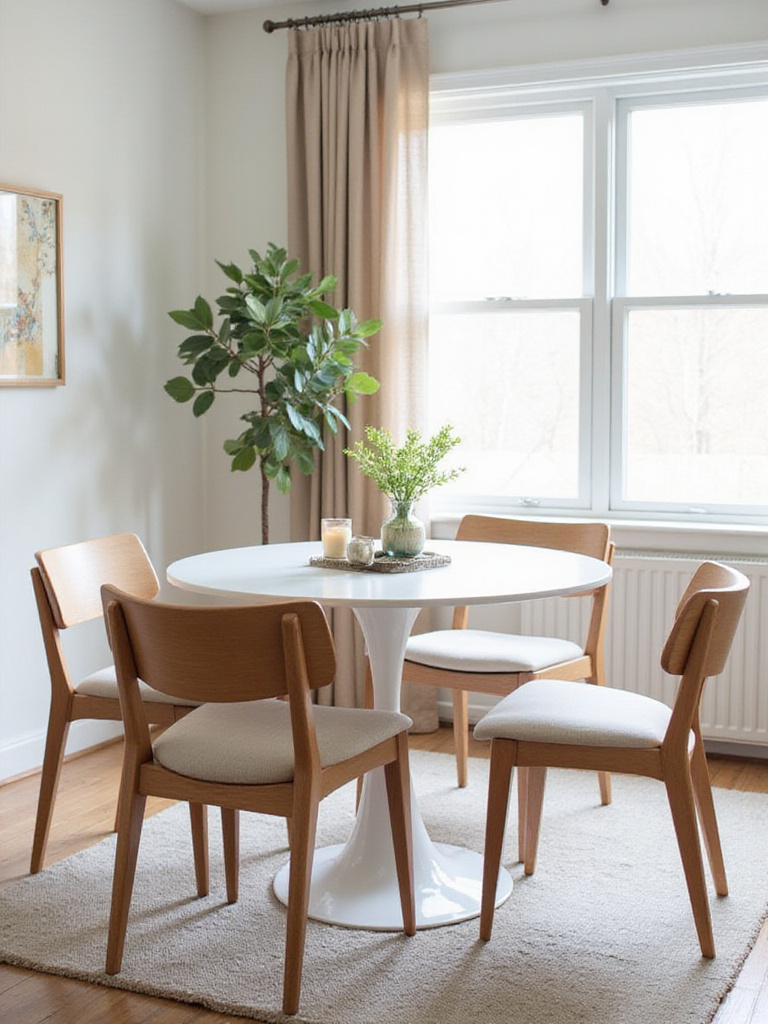
The principle extends beyond just dimensions to overall design philosophy. Furniture that appears to float slightly above the floor—whether on hairpin legs or tapered supports—maintains sight lines and allows light to flow underneath. This negative space becomes part of the room’s visual breathing room, contributing to an airier atmosphere.
The craftsmanship reveals itself in details like precisely proportioned legs that provide adequate support without appearing heavy or intrusive.
The ability to tuck chairs completely beneath the table transforms the room’s functionality when dining isn’t happening. This seemingly simple feature can reclaim several square feet of floor space, dramatically improving traffic flow and making the area feel more open. The visual impact is equally important—a clear floor plane makes any room appear larger.
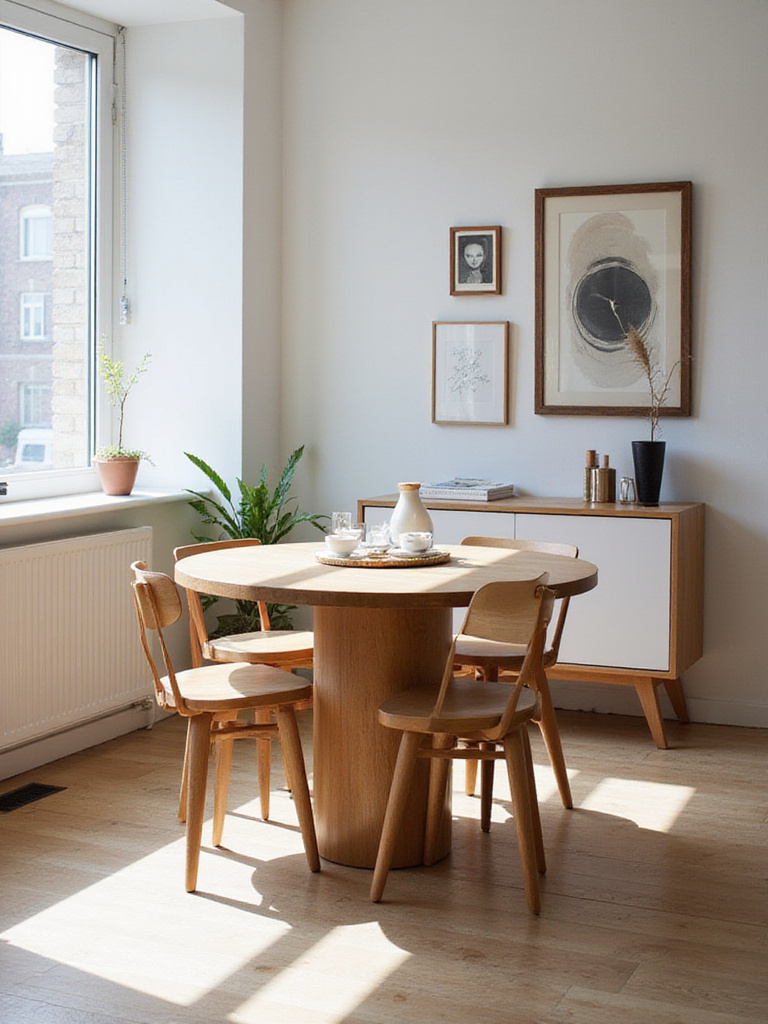
Achieving this requires careful attention to measurements. The chair’s highest point, including arms if present, must clear the table’s apron or lowest edge. Armless designs or chairs with very low, narrow arms typically work best. The goal is complete concealment, creating a clean, uncluttered appearance when the dining function is dormant.
The styling mistake most people make is choosing chairs based on appearance alone without confirming they’ll tuck properly under their specific table.
Solid table surfaces can feel like barriers in small spaces, visually dividing the room and blocking sight lines. Glass tops maintain the table’s functionality while allowing light and views to pass through unobstructed. This transparency prevents the table from feeling like a massive object dominating the room, instead creating an almost floating effect.

The material choice also amplifies available light by reflecting and refracting both natural and artificial illumination. This brightening effect makes the entire space feel more open and welcoming. Glass pairs particularly well with interesting base designs, allowing the table’s structural elements to become decorative features rather than hidden supports.
As morning light filters through, the texture creates subtle plays of reflection and refraction that add visual interest without consuming physical space.
Furniture sitting directly on the floor creates visual weight that can make small rooms feel heavy and crowded. Pieces elevated on legs allow light and sight lines to flow underneath, creating negative space that contributes to an airier feeling. This technique works because it extends the visible floor area, making the room appear larger than its actual dimensions.
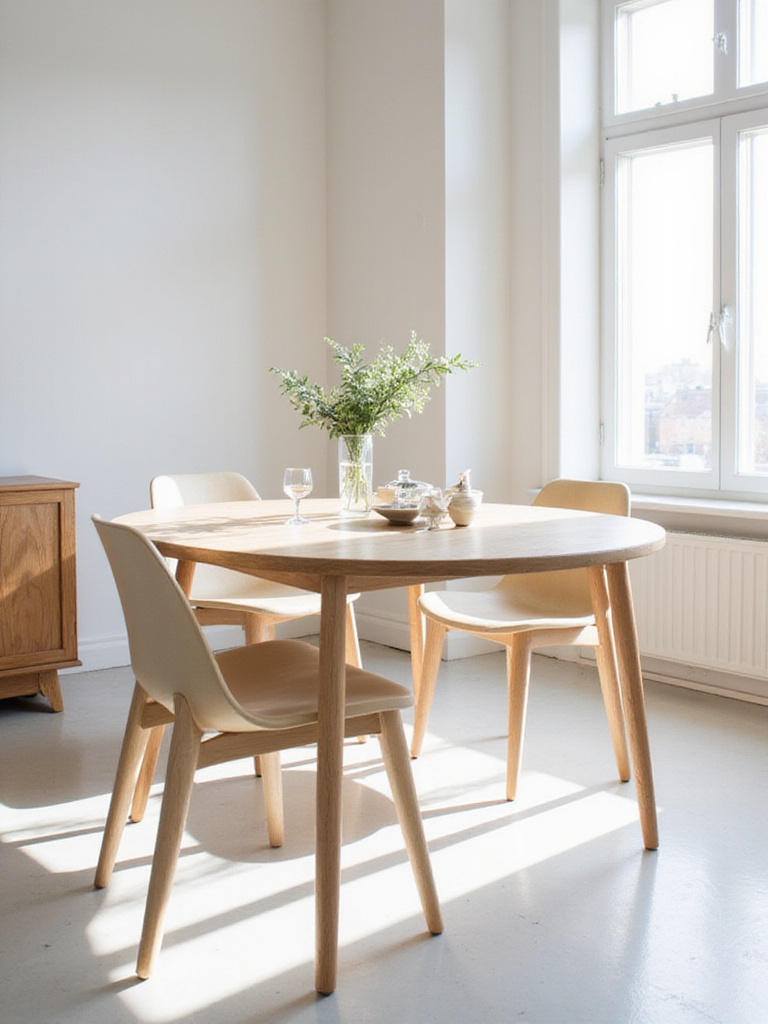
The effect is most pronounced when the legs are proportionate to the furniture piece—substantial enough to look intentional but slim enough to maintain the lightness principle. Materials like wood, metal, or even acrylic can work effectively, depending on the overall design aesthetic you’re pursuing.
The composition comes together when you combine multiple leggy pieces, creating a cohesive look that maximizes the visual flow throughout the space.
Strategic mirror placement can fundamentally alter how a small dining room feels by reflecting light and creating the illusion of extended space. The most effective approach involves positioning a large mirror to reflect either a window or the room’s most attractive features, essentially creating a second visual dimension that doubles the perceived area.
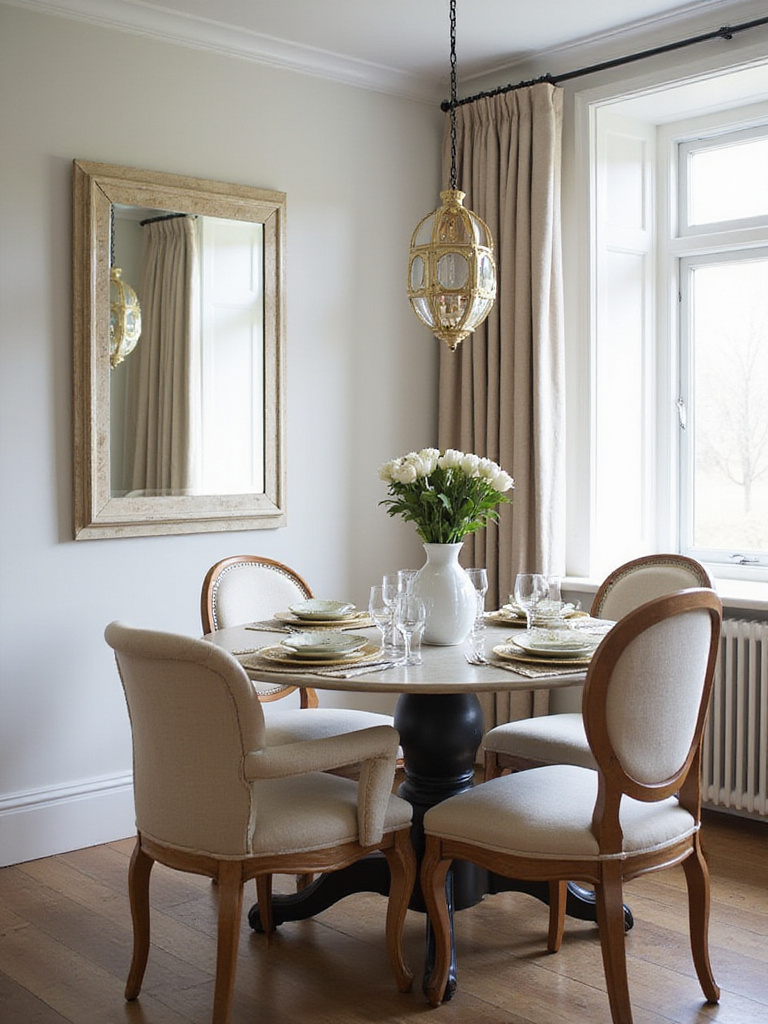
The key is thoughtful placement rather than random mirror installation. A mirror opposite a window reflects natural light deeper into the room while creating the impression of additional windows. Similarly, mirrors that reflect attractive architectural details or well-styled areas amplify the positive visual elements while minimizing attention to the room’s limitations.
The unexpected environmental benefit comes from reduced reliance on artificial lighting, as mirrors naturally amplify available daylight throughout the space.
Color psychology plays a crucial role in spatial perception. Light colors reflect more light than dark ones, creating brighter environments that feel more expansive. This isn’t just about white walls—soft grays, warm creams, and pale blues can all contribute to a sense of openness while adding more personality than stark white.
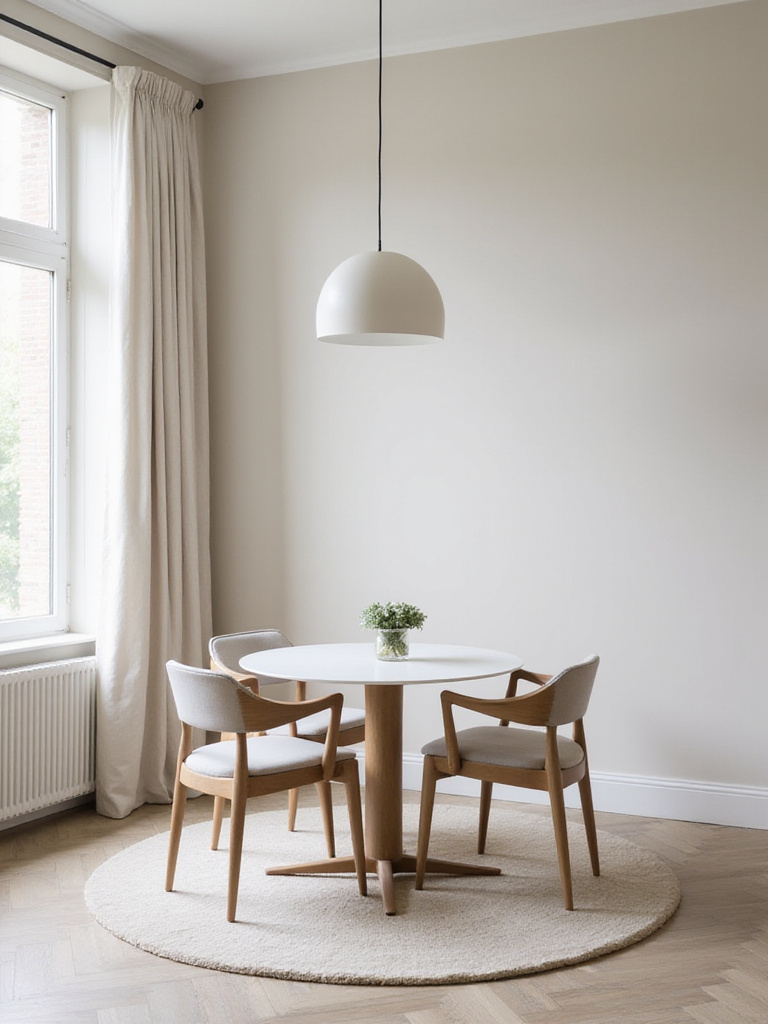
The science involves Light Reflectance Values (LRV), which measure how much light a color reflects. Colors with LRV ratings above 70% are generally considered light and space-enhancing. The goal is maximizing the reflection of both natural and artificial light to create the brightest, most open-feeling environment possible within your existing space.
The subtle fragrance fills the room while the carefully chosen paint color works continuously to bounce light and expand visual boundaries.
Single overhead fixtures create flat, shadowless environments that make spaces feel smaller and less inviting. Layering different types of lighting—ambient, task, and accent—adds visual depth and dimension that enhances the perception of space. This approach also provides functional flexibility for different activities and times of day.
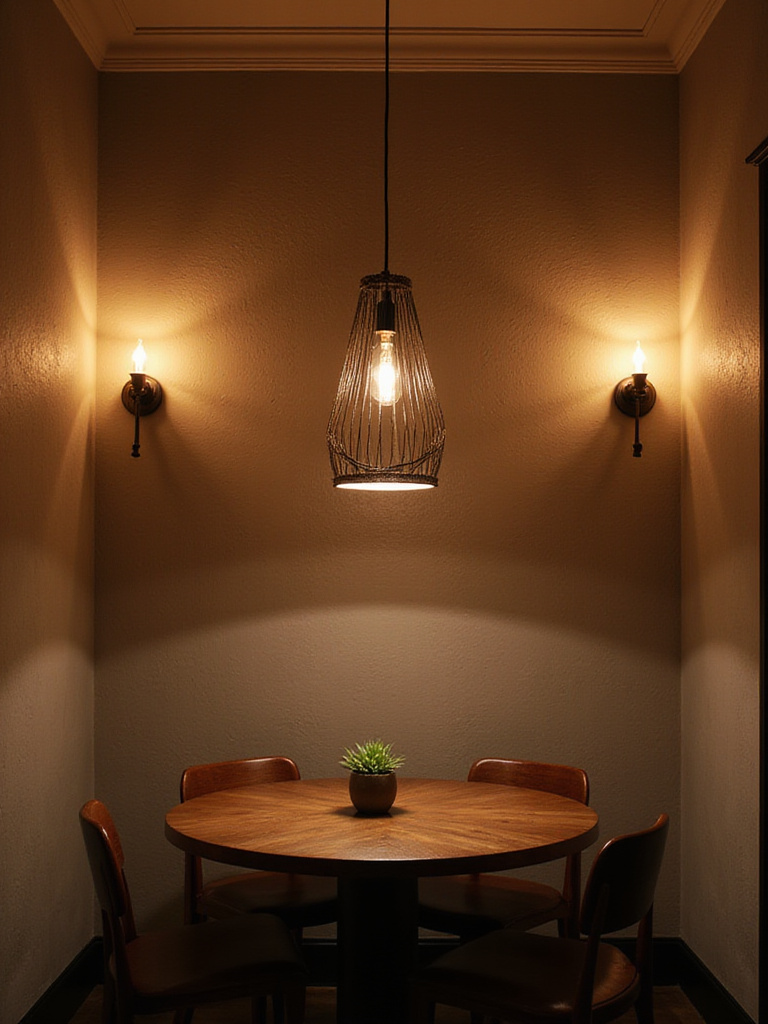
Effective layering might include a pendant over the table for Task Lighting, wall sconces for ambient illumination, and perhaps a small lamp on a sideboard for accent lighting. Dimmer controls on each layer allow precise mood adjustment, transforming the space from bright and functional during meals to soft and intimate for conversation.
The mood shifts dramatically when you add warm-toned bulbs (2700K-3000K) across all layers, creating cohesive illumination that enhances both functionality and atmosphere.
Floor space is limited, but wall space often goes underutilized. Tall, narrow shelving units can provide substantial storage capacity without consuming valuable floor area. This vertical approach draws the eye upward, making the room feel taller while addressing practical storage needs for dishes, glassware, and dining accessories.
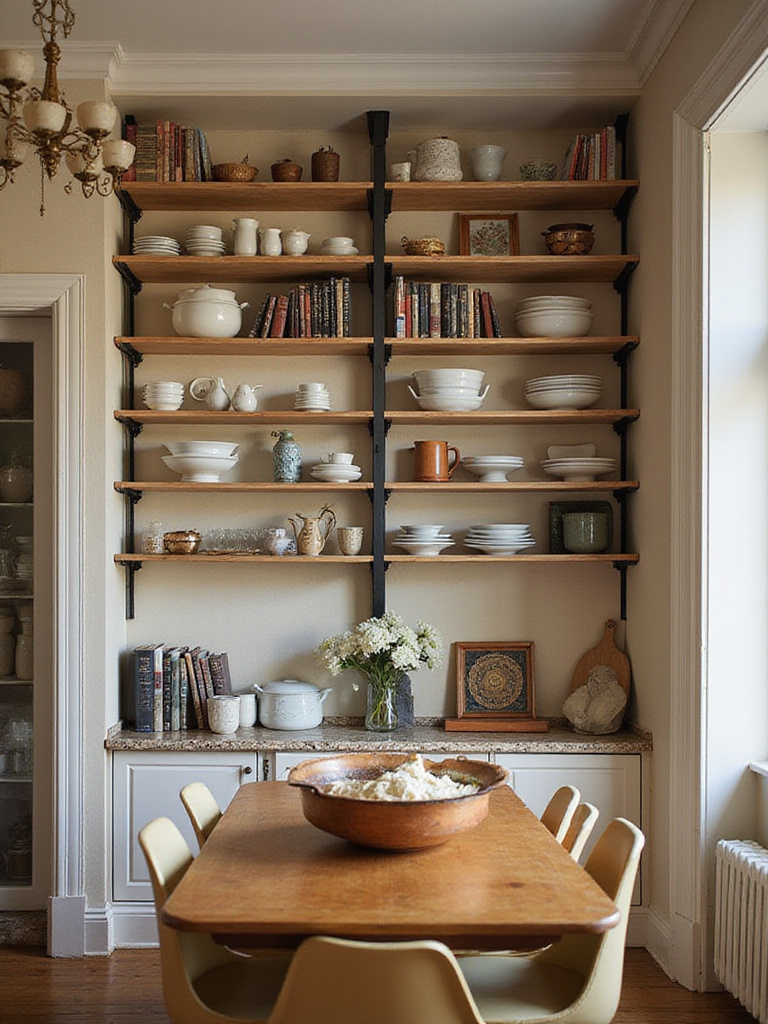
The most effective tall storage solutions extend close to the ceiling, maximizing capacity while maintaining proportional relationships with the room. Open shelving keeps the visual weight light, while a mix of open and closed storage allows for both display and concealed organization of less attractive necessities.
The artisan collective that creates these pieces understands that vertical storage must balance function with visual lightness to succeed in small spaces.
Room corners often become dead zones, but they represent valuable real estate in small dining areas. A corner-positioned table can provide comfortable seating for 2-4 people while freeing up central floor space for better traffic flow. This placement creates a defined dining zone without requiring the table to be the room’s central focus.
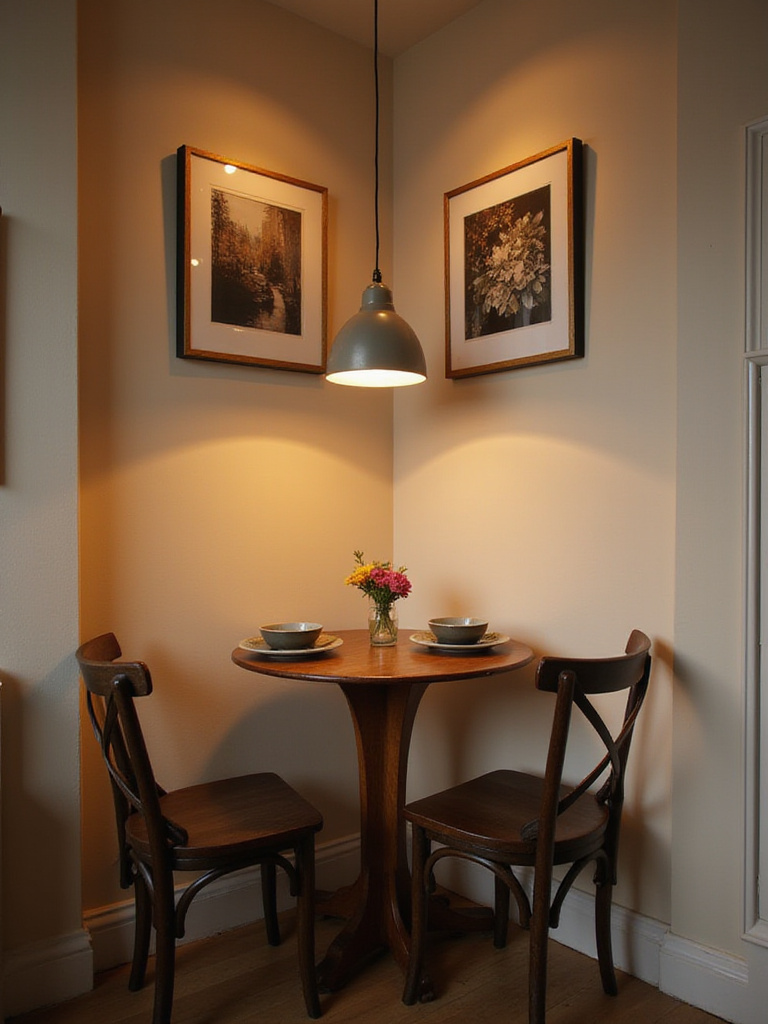
Corner placement works particularly well with round tables, which soften the angular intersection of walls while maximizing seating efficiency. The approach also allows for creative seating solutions like built-in banquettes or benches that make the most of the available space while creating an intimate dining experience.
The traditional methods used result in corner dining areas that feel intentional and cozy rather than cramped or awkward.
In open-concept spaces, furniture can appear to float without purpose. A well-proportioned rug beneath the dining table creates visual boundaries that define the eating area as distinct from adjacent living or kitchen zones. This definition helps organize the space mentally while adding warmth and texture to hard flooring surfaces.
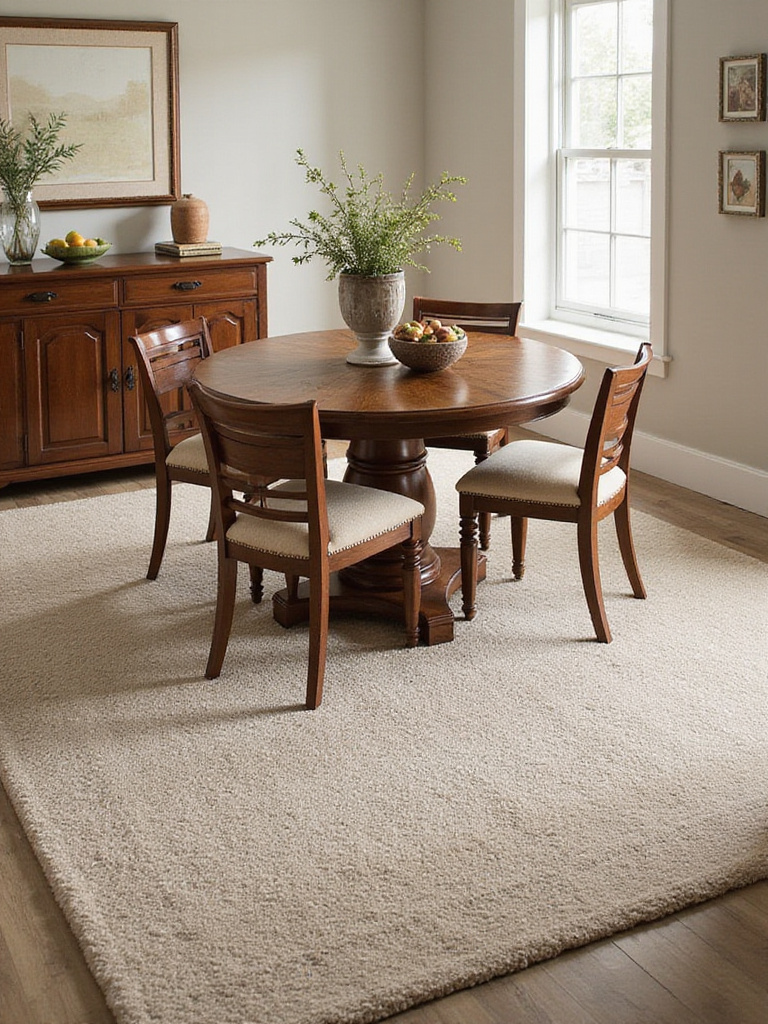
The rug must be large enough to accommodate chairs when pulled out—typically extending 24-30 inches beyond the table on all sides. This ensures chairs remain on the rug during use, maintaining the visual connection between furniture pieces and preventing the awkward appearance of partially off-rug seating.
The visual weight balances perfectly when you choose low-pile, easy-to-clean materials that can handle dining-related spills while maintaining their appearance over time.
Wall-mounted solutions represent the ultimate in space efficiency, completely eliminating floor footprint when not in use. Beyond fold-down tables, consider wall-mounted shelving, storage units, or even specialized dining furniture designed to fold flat against walls. These solutions work particularly well in multi-purpose spaces that need to transform throughout the day.
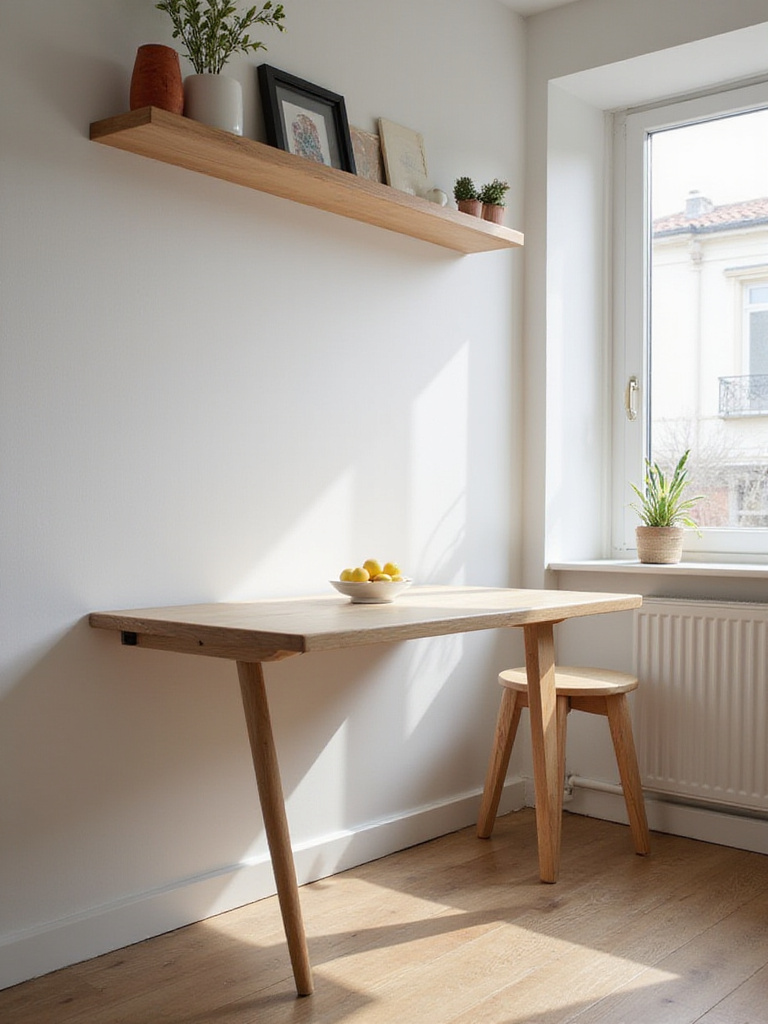
The installation requires careful attention to wall structure and appropriate hardware, but the payoff in spatial flexibility is substantial. Wall-mounted pieces can often support surprising weight loads when properly installed, making them practical for full dining service rather than just light snacks.
The collaboration began with a conversation about how urban living demands furniture that adapts to changing needs rather than consuming space permanently.
Every decorative object consumes visual space, even if it doesn’t take up floor area. In small dining rooms, restraint in decoration creates cleaner sight lines and reduces the feeling of clutter that can make spaces feel cramped. The goal is thoughtful curation rather than complete emptiness—a few well-chosen pieces create more impact than numerous small items.
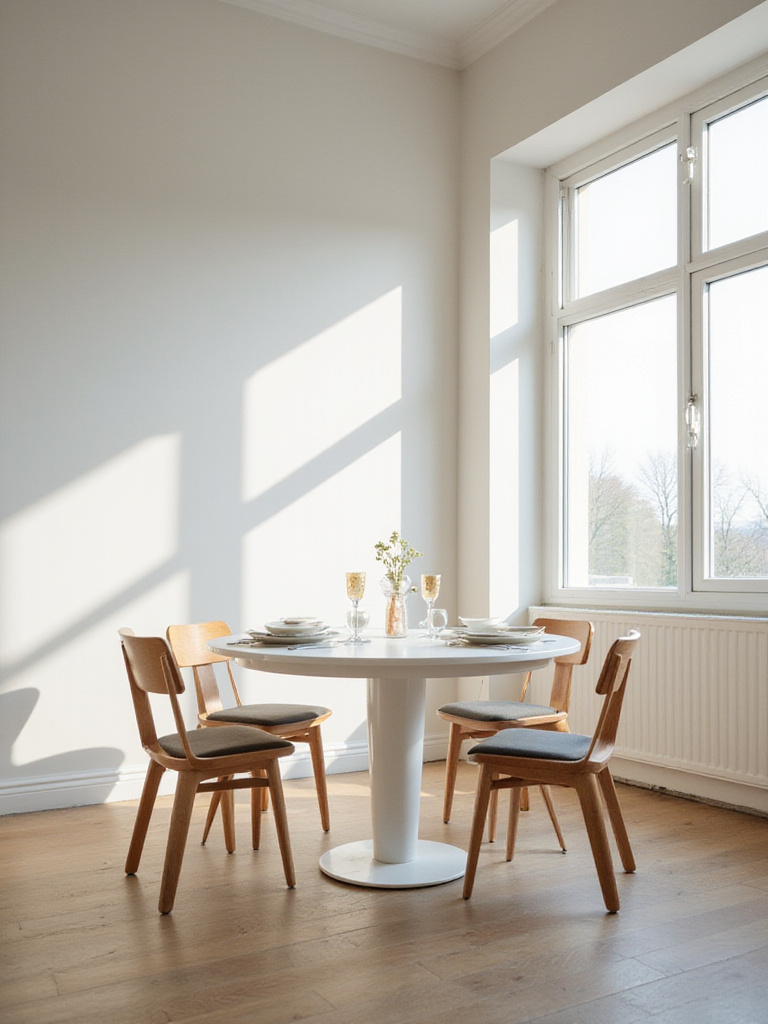
Minimal doesn’t mean sterile. A single statement piece of art, a carefully chosen centerpiece, or a few plants can add personality without overwhelming the space. The key is ensuring each decorative element earns its place through beauty, function, or personal meaning rather than filling space out of habit.
The finishing touch that elevates the entire look is the discipline to resist over-decorating, allowing the space itself to breathe.
Before implementing any design strategy, removing unnecessary items provides the most dramatic spatial improvement. Decluttering isn’t just about tidiness—it’s about reclaiming both physical and visual space that accumulated possessions consume. This process often reveals spatial possibilities that weren’t apparent when the room was crowded with non-essential items.
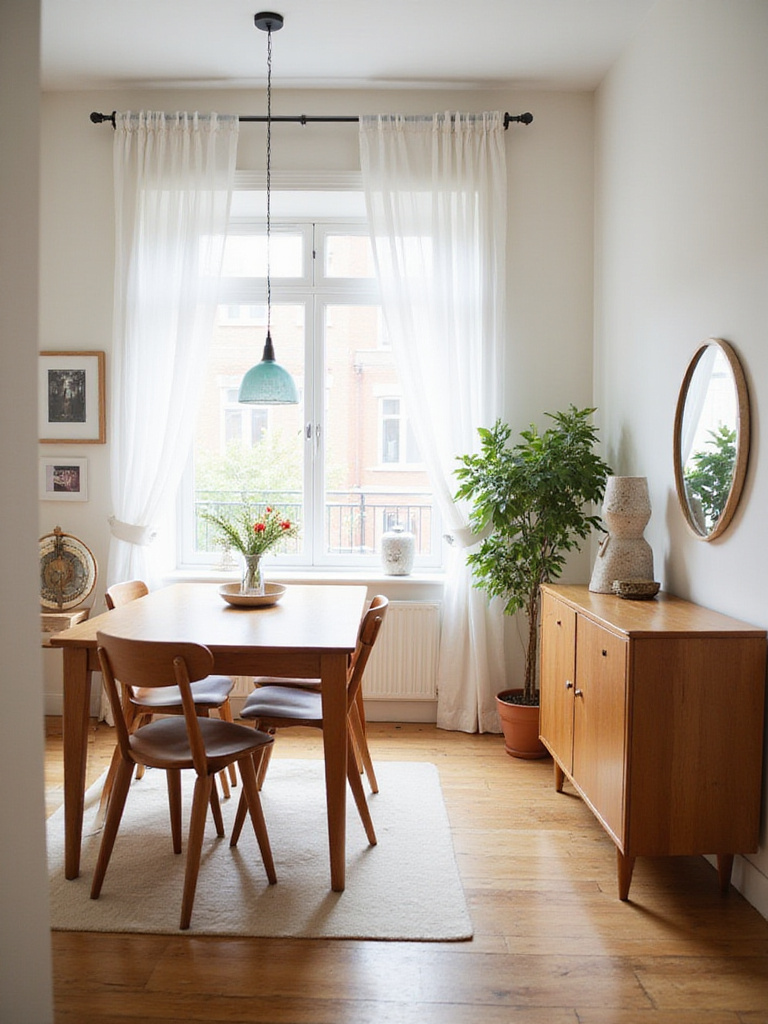
Effective decluttering requires honest assessment of each item’s necessity and frequency of use. Items that haven’t been used in the past year, duplicates of things you already have, and objects that don’t contribute to the dining experience should be removed. The goal is keeping only what actively serves your needs or brings genuine joy to the space.
The sustainable journey of this material involves recognizing that less stuff often means more space, more peace, and more appreciation for the items you choose to keep.
Transforming a small dining room into a functional, beautiful space doesn’t require expanding your square footage—it requires expanding your perspective on how space can work. These 18 small dining room ideas demonstrate that limitations often spark the most creative solutions. From furniture that disappears when not needed to visual tricks that expand perceived boundaries, each strategy addresses the fundamental challenge of making small spaces feel larger and more purposeful.
The most successful approaches combine multiple techniques, layering space-saving furniture choices with visual expansion strategies and organizational systems. Whether you implement a fold-down table for ultimate flexibility, use mirrors to double your perceived space, or simply declutter ruthlessly to reveal hidden potential, each change contributes to a more spacious, more functional dining environment.
Remember that small doesn’t mean compromised. With thoughtful planning and strategic choices, your compact dining area can become one of your home’s most cherished spaces—a place where size matters far less than the memories you create around the table. Start with one or two strategies that resonate most with your space and lifestyle, then build from there as you discover what works best for your unique situation.